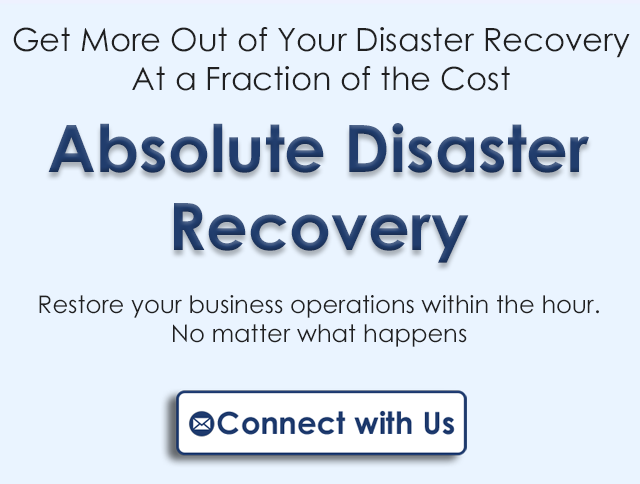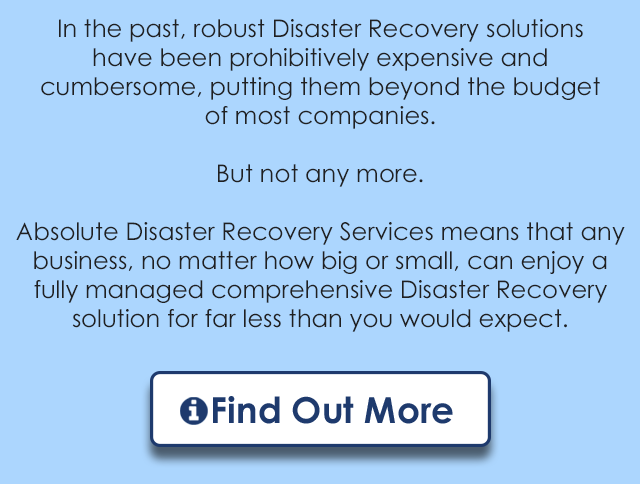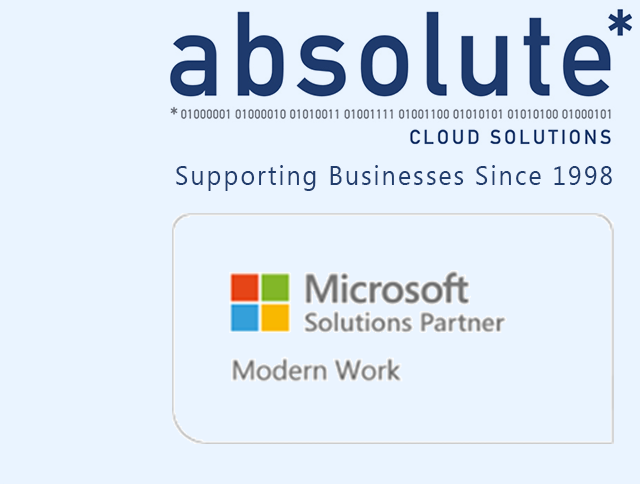
Our Company has a robust back up solution in place. Is disaster recovery really all that necessary?
Absolutely. A recent poll has shown that while over 70% of companies world wide have some form of back up solution in place, 93% of companies that suffered a major disruption to business without an adequate disaster recovery plan in place never fully recovered, with the majority of them closing their doors permanently within the year.
Conversely, 96% of companies with a disaster recovery plan fully recover with minimal impact to their business operations.
“93% of companies that suffered a major disruption to business without an adequate disaster recovery plan in place never fully recovered”
But what is the difference between a backup solution and a Disaster Recover service? Don’t both just restore your data?
Imagine a scenario where your Server is out of commission due to physical damage like a fire, water damage, crashed hardware or a major cyber-attack involving Ransomware or something similar.
In cases like these, even if you had all the backups in the world, where would you restore that data to and how long would that take? It takes time to repair a complex piece of equipment like a company server. Could you really afford to have your business come to a
total standstill while waiting for parts to be delivered and installed or the reformatting of your Server and reinstating of all that data? Disaster Recovery is all about getting your company up and running quickly with minimal productivity loss.
“Our belief that there must be a better way has led us to leverage the latest in Cloud technology and combine this with a Managed Service. All in order to provide an unsurpassed level of Business Continuity”
So your service offers us a back up server that we can access in case of an emergency? Isn’t that the same as any other Disaster Recovery Solution?
In the past, the norm in the Disaster Recovery landscape involves a client such as yourself co-renting physical space and services, including a location to work from be it a desk or an office of desks, an Internet connection as well as the large initial capital outlay for necessary equipment replication. This service comes at a financial premium as in essence not only are you paying for the management of the service, you are also paying rent for a second office and all the utilities attached to that office. These costs can quickly add up. The old school way of doing Disaster Recovery not only makes for a more time consuming and cumbersome process, it also means that historically it was out of reach of all but the largest of companies who could foot the bill.
Our belief that there must be a better way has led us to leverage the latest in Cloud technology and combine this with a Managed Service. All in order to provide an unsurpassed level of Business Continuity that any company, regardless of size can not only afford, but can’t afford to go without.
Is it really that much more affordable than traditional Disaster Recovery solutions?
Unlike with traditional solutions, with Absolute Disaster Recovery you won’t be paying for any physical office or server equipment on the off chance you need it. You also won’t need to account for the massive capital outlay to replicate any necessary equipment. A big benefit of Cloud technology is that you only need to pay for exactly what processing resources and data storage space you need. This means that your monthly out-of-disaster cost is based solely on the number of servers and the amount of data you have. Your in-disaster operating costs are based on Cloud resources your company uses. This is charged per hour so you only pay for exactly what you need, when you need it.
“All of this makes for a drastically more affordable and manageable service compared to the traditional Disaster Recovery solutions.”
Additionally, this allows us to accurately forecast your in-disaster operating costs so that there are no financial surprises. All of this makes for a drastically more affordable and manageable service compared to the traditional Disaster Recovery solutions.
“In simple terms, this means that no matter what happens to your physical servers, your company can be up and running within the hour, with as little as 20 minutes of lost work.”
I would imagine that this would be the case in any disaster recovery scenario?
In the past this held true, but Absolute has leveraged the flexibility of the Cloud to skip all the physical labours and delays involved in getting your company up and running. Imagine all the benefits of a traditional Disaster Recovery solution with none of the delay and at a fraction of the monthly cost. Due to the reduced logistics involved, Absolute Disaster Recovery services can provide you with the best Return To Operation (RTO) and Restore Point Objective (RPO) possible. In simple terms, this means that no matter what happens to your physical servers, your company can be up and running within the hour, with as little as 20 minutes of lost work.
So a 20 minute RPO. That sounds great in theory, but surely that would involve lots of backups? A big concern I have is that backups always seem to slow everything down and they take forever to finish. Won’t our server performance be impacted with multiple backups happening throughout the day?
That’s a good question, and a very reasonable concern to have. Backups take so long because your server is having to write all your data onto a series of physical hard drives. We get around this by cloning your entire server to the Cloud. After the initial backup takes place, we then check for any changes to the data on your server a few times every hour. This means that the data being uploaded in every instance is just a fraction of the whole and as such, the performance impact on your server and Internet connection is so small that you won’t even notice it.
“Vastly improved Return To Operation (RTO) time when compared to moving all your staff to another workspace as you would need to do with the more expensive traditional Disaster Recovery solutions.”
OK that makes sense. On the same note. How can you offer a 1 hour RTO? Surely we would need to move to a temporary site and light up the servers just like with a traditional Disaster Recovery service?
In the event of your Server going down while the rest of your company workspace remains intact, all we need to do is switch over to your cloned server in the Cloud. A tested process that can be done within the hour. This makes for a vastly improved Return To Operation (RTO) time when compared to moving all your staff to another workspace as you would need to do with the more expensive traditional Disaster Recovery solutions.
But what if, heaven forbid, our whole building burned down, workspaces and all?
This is where the flexibility of Cloud technology truly shines.
Even if you no longer have a usable office workspace, with Absolute Disaster Recovery services your staff could proceed with business as usual from any PC or laptop with an Internet connection. They could work from home, from a temporary office space that you only pay for as needed, or even from a library, coffee shop or Internet café.
So in place of a fixed hotsite we could instead work from anywhere as needed?
Exactly. With a traditional solution, if your server were to go down at the wrong time you could end up losing hours, perhaps even days’ worth of work due to less frequent backups and the logistics of relocating your base of operations to a remote hotsite. Absolute Disaster Recovery services addresses both of these drawbacks offering you a better, more flexible solution at a more affordable fixed out-of-disaster monthly fee.
“A better, more flexible solution at a more affordable fixed out-of-disaster monthly fee.”
Let me get this right then, in essence Absolute Disaster Recovery services means less overall risk to my business as well as improved performance, flexibility and peace of mind, all while being more affordable than a traditional Disaster Recovery Solution?
You got it. So much more for so much less.
No matter what happens, Absolute Disaster Recovery services will ensure that you get through it all in one piece.






